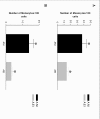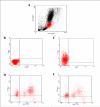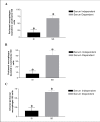In vitro binding and survival assays of Leishmania parasites to peripherical blood monocytes and monocyte-derived macrophages isolated from dogs naturally and experimentally infected with Leishmania (Leishmania) chagasi
- PMID: 17537246
- PMCID: PMC1894629
- DOI: 10.1186/1746-6148-3-11
In vitro binding and survival assays of Leishmania parasites to peripherical blood monocytes and monocyte-derived macrophages isolated from dogs naturally and experimentally infected with Leishmania (Leishmania) chagasi
Abstract
Background: There are a few works considering the characterization of canine monocyte-derived macrophages as well as a standardized procedure for isolation, culture, and infection of these cells with Leishmania. We have performed several modifications in order to improve the canine monocyte-derived macrophage cultures. In addition, we have done a comparative study between monocytes and monocyte-derived macrophages from dogs naturally and experimentally infected with L. chagasi.
Results: In the presence of exogenous serum, opsonized Leishmania promastigotes binds better to monocytes/macrophages than without serum. Otherwise, this binding occurs due to the strict correlation between the opsonized biologic particles with the third receptor of the complement (CR3-CD11b/CD18). In fact, our assays with CD11b confirmed the importance of this receptor for canine cells and the L. chagasi experimental system. Moreover, monocytes obtained from naturally infected dogs have shown a higher number of monocytes bounded to promastigotes. The experimental results regarding survival have shown that promastigote forms of opsonized L. chagasi were more infective, because we found higher numbers of promastigotes bound to the different cells. As a consequence, after forty-eight hours of binding, higher numbers of amastigotes appeared inside monocyte-macrophages.
Conclusion: These studies have given support to continue comparative studies involving canine monocytes, monocyte-derived macrophages and peritoneal macrophages. Since we have standardized the canine cell culture, we are looking forward to determining the phenotypic properties of these cells before and after L. chagasi infection using flow cytometry.
Figures








Similar articles
-
Histopathological and immunohistochemical study of type 3 complement receptors (CD11b/CD18) in livers and spleens of asymptomatic and symptomatic dogs naturally infected with Leishmania (Leishmania) chagasi.Vet Immunol Immunopathol. 2007 May 15;117(1-2):129-36. doi: 10.1016/j.vetimm.2007.02.012. Epub 2007 Feb 28. Vet Immunol Immunopathol. 2007. PMID: 17383741
-
Serological evaluation of experimentally infected dogs by LicTXNPx-ELISA and amastigote-flow cytometry.Vet Parasitol. 2008 Nov 25;158(1-2):23-30. doi: 10.1016/j.vetpar.2008.09.001. Epub 2008 Sep 6. Vet Parasitol. 2008. PMID: 18848397
-
Long-lasting protection against canine visceral leishmaniasis using the LiESAp-MDP vaccine in endemic areas of France: double-blind randomised efficacy field trial.Vaccine. 2007 May 22;25(21):4223-34. doi: 10.1016/j.vaccine.2007.02.083. Epub 2007 Mar 15. Vaccine. 2007. PMID: 17395339 Clinical Trial.
-
Systemic and compartmentalized immune response in canine visceral leishmaniasis.Vet Immunol Immunopathol. 2009 Mar 15;128(1-3):87-95. doi: 10.1016/j.vetimm.2008.10.307. Epub 2008 Oct 17. Vet Immunol Immunopathol. 2009. PMID: 19054576 Review.
-
Advances in the pathogenesis of canine leishmaniosis: epidemiologic and diagnostic implications.Vet Dermatol. 2009 Oct;20(5-6):471-89. doi: 10.1111/j.1365-3164.2009.00823.x. Vet Dermatol. 2009. PMID: 20178485 Review.
Cited by
-
Analysis using canine peripheral blood for establishing in vitro conditions for monocyte differentiation into macrophages for Leishmania chagasi infection and T-cell subset purification.Vet Parasitol. 2013 Nov 15;198(1-2):62-71. doi: 10.1016/j.vetpar.2013.08.014. Epub 2013 Aug 22. Vet Parasitol. 2013. PMID: 24018185 Free PMC article.
-
Toll receptors type-2 and CR3 expression of canine monocytes and its correlation with immunohistochemistry and xenodiagnosis in visceral leishmaniasis.PLoS One. 2011;6(11):e27679. doi: 10.1371/journal.pone.0027679. Epub 2011 Nov 30. PLoS One. 2011. PMID: 22140456 Free PMC article.
References
-
- Deane LM, Deane MP. Visceral leishmaniasis in Brazil: geographical distribution and trnsmission. Rev Inst Med Trop Sao Paulo. 1962;4:198–212. - PubMed
-
- Pinelli E, Rutten VP, Bruysters M, Moore PF, Ruitenberg EJ. Compensation for decreased expression of B7 molecules on Leishmania infantum-infected canine macrophages results in restoration of parasite-specific T-cell proliferation and gamma interferon production. Infect Immun. 1999;67:237–243. - PMC - PubMed
-
- Shaw SE, Anderson NV. Isolation and functional analysis of normal canine blood monocytes and resident alveolar macrophages. Am J Vet Res. 1984;45:87–90. - PubMed
Publication types
MeSH terms
LinkOut - more resources
Full Text Sources
Research Materials

